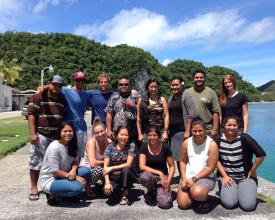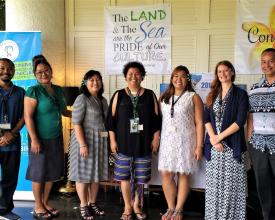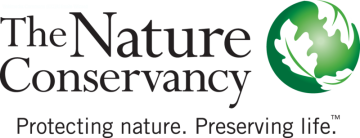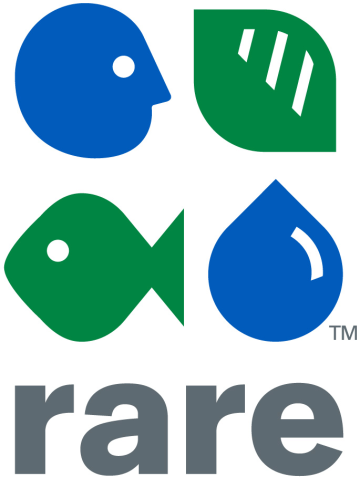Micronesia Challenge: A Regional Commitment for Protected Area Management
The Micronesia Challenge is a commitment by the five Micronesian countries and territories, and the partners of their regional support teams to preserve the natural resources that are crucial to the survival of Pacific traditions, cultures and livelihoods. The overall goal of the Challenge is to effectively conserve at least 30% of the near-shore marine resources and 20% of the terrestrial resources across Micronesia by 2020.
Context
Challenges addressed
Micronesia’s islands are exemplary microcosms for conservation and resilience, with some habitats and natural communities found nowhere else on Earth. Yet these features also make them especially vulnerable to environmental threats such as unsustainable fishing practices, invasive species and deforestation - all compounded by climate change.
Location
Process
Summary of the process
Building Blocks
High Level Political Leadership & Commitment
The announcement of the Micronesia Challenge in 2006 was the culmination of decades of work by Micronesian people and organizations to raise awareness and strengthen the capacity across this region to conserve and sustainably manage natural resources. In early 2006, the Chief Executives of each of the jurisdictions signed the Micronesia Challenge and presented it to the international community at a high level event at the 8th Conference of the Parties (COP8) to the UN Convention on Biological Diversity (CBD) in March 2006 in Brazil. The decades of groundwork combined with the right timing and publicity at the COP8 created a moment when political leaders challenged each other to make this ambitious commitment. They were far more ambitious than even the Aichi Targets that would follow in 2011 (17% terrestrial and 10% marine by 2020). The fact that political leaders at the highest level and across the region committed to this target catalyzes both local implementation and international finance to conservation in Micronesia. Now the Micronesia Challenge has become an established institution, mainstreamed into government priorities and surviving turnover in administrations in every one of the five participating jurisdictions.
Enabling factors
- Political will and dedication of individual island leaders, who coordinate through the MC Regional Office (MC Regional Coordinator and the MC Steering Committee appointed by the chief executives of the jurisdictions)
- Support from the Micronesia Challenge Regional Support Team (RST), which includes national and international partners, as well as local conservation NGOs in each island, and the Measures Working Group that develops indicators and tracks progress
Lesson learned
- Bringing dedicated and active leaders together at the highest level can create momentum for ambitious commitments that are more powerful than individual nations’ commitments
- Strong partnerships at local to regional level to support accelerated progress toward the commitment.
- Regional commitments like the Micronesia Challenge can be replicated in other regions that have strong leadership. Through the Global Island Partnership, the MC has inspired other challenges such as the Caribbean Challenge Initiative (CCI), the Western Indian Ocean Coastal Challenge (WIOCC), the Aloha+ Challenge, the Two Samoas’ Initiative, and the Coral Triangle Initiative.
Building Strong Partnerships with Regional Identity & GLISPA
The Micronesia Challenge spans 5 jurisdictions, thousands of islands and more than 650,000 people speaking 12 different languages. Many key partners (listed above) collaborate on the Micronesia Challenge to support and implement a joint commitment across the region. Using the shared regional and cultural identity of being Micronesian has been a powerful way to create lasting partnerships among local and grassroots organizations to share lessons learned and feel a sense of common cause. Moreover, the reliable and firm commitment of the highest political leaders draws international partners to invest time and resources in building new relationships, because investors and partners know conservation has the full support of the political leadership.
Enabling factors
Shared cultural heritage allows for a regional identity as Micronesian, which helps unite diverse stakeholders and jurisdictions. The Global Island Partnership (GLISPA), led by the President of Palau alongside the President of Seychelles and Prime Minister of Grenada, plays an important role of showcasing the Micronesia Challenge on the international stage. This helped maintain momentum in implementation of the MC as well as inspiring other leaders to make similar commitments such as the Caribbean Challenge Initiative and Aloha+ Challenge.
Lesson learned
- It requires continuous work to maintain the MC partnerships and coordinate conservation action in the region. The broad support from local and high levels, the ambitious targets, and the sense of common cause in the region motivate the partners to work together, learn from each other, and strive to live up to the Micronesia Challenge.
- A strong network of partners inspires new and leverages existing regional opportunities to draw additional partners and funding to the region that go beyond the MC targets. Examples are the world’s first Regional Shark Sanctuary in Palau, the Micronesia Biosecurity Plan to address the risk of spread of invasive species, the Young Champions Internship Program, the German Lifeweb Support for community-based climate adaptation and resilience, the NOAA Partnership Agreements for coral reef conservation, and the RARE Pride Social Marketing Campaigns.
Sustainable Financing: PAN Funds and Endowments
First, each jurisdiction developed sustainable finance plans, including financing targets, strategies, and the creation of Protected Area Network (PAN) Funds. For example, Palau created a Green Fee, and FSM and RMI are working on Tuna Licensing Fee legislation and a tourism fee to support sustainable financing of the Micronesia Challenge. Pohnpei and Kosrae State are creating PAN funds and are evaluating an amendment to the airport tax law to allow some of the departure fees to go into the FSM's Micronesia Challenge Endowment Fund. Additionally, several other sustainable financing schemes have been and/or are being set up (i.e. the Yela Conservation Easement Endowment, the Awak Sustainable Community Development Revolving Fund, the Nett Water Fund). An endowment for the MC is another important component to sustainable financing. Interest income from an endowment of approximately $56 million ($17 million as of 2015) will be needed to supplement local sources for the long-term sustainability of the MC in all five jurisdictions. Although the endowment funds are invested together, each jurisdiction has their own sub-account and will develop their own dissemination mechanisms for their interest income.
Enabling factors
- The Micronesia Conservation Trust (founded 2002) had structure and relationships in place prior to receiving funds, which was a key component to project success. Past success with pass-through grants helped build credibility.
- The Endowment was seeded with over $11 million from the Global Environment Facility, The Nature Conservancy (TNC), and Conservation International, and leveraged additional resources from the countries.
- Innovative financing ideas are being developed in each of the five jurisdictions and at the community level
Lesson learned
- Regional conservation trusts can be a powerful mechanism for building capacity and creating a hub for regional networks and partnerships, and MCT has served as a model for other regional funds, such as the Caribbean Biodiversity Fund (CBF) established in 2012.
- The Micronesia Challenge incentivizes longer-term planning, because criteria such as establishing management plans are required before tapping into the endowment funds.
- Innovative financing mechanisms developed in one jurisdiction or by one community can be replicated and scaled in other places, because the Micronesia Challenge encourages sharing of information to achieve a regional goal.
Impacts
1. More Area Under Effective Conservation: The MC helped to establish or strengthen 150 conservation areas. Micronesia is on track for its 2020 goals of protecting 30% of marine and 20% of terrestrial resources (more than half of these area targets have already been achieved). The MC Measures Working Group also developed the Managed and Protected Area Management Effectiveness (MPAME)Tool. Communities use this tool to improve their management by comparing and keeping track of PA effectiveness across 12 categories based on data from long term monitoring programs. 2. Sustainable Financing: Effective conservation requires a range of financing mechanisms at the local and national level, such as Green Fees, tourism fees or tuna licensing fees. In addition, an endowment of $56 million is being created to generate additional annual funds necessary to support management activities. As of 2019, the endowment has reached nearly $20million. 3. Replication in other Regions: Since 2006, the Micronesia Challenge has proven to be a successful and scalable solution. The Coral Triangle Initiative (CTI) followed its lead in 2008, the Western Indian Ocean Coastal Challenge (WIOCC) in 2012 and the Caribbean Challenge Initiative (CCI) in 2013.
Beneficiaries
- Communities and households in Micronesia who depend on coastal, marine and terrestrial resources for their livelihoods
- Big ocean initiatives in other regions (WIOCC, CCI, CTI, Aloha+)
Sustainable Development Goals
Story
When one island becomes two – Ben’s Story In 2005, Ben Namakin stood on Dekehtikin, his favorite small atoll island off Pohnpei, FSM, and couldn’t believe his eyes. The island that he used to picnic on and snorkel around as a high school student with his friends had been split in two, the ocean now flowing over what was once dry land, washing away precious soil and sand with every wave. For Ben, the looming specter of climate change now had a new and much more personal meaning. “Yes, it might be natural,” says Namakin, “but maybe people have something to do with it. I’m just very concerned about future generations.” Since then, the soft-spoken 28-year-old has been determined to share his experiences and the stories of other Pacific Islanders with anyone who will listen, and he has been quite successful in garnering both local and international attention to his activities and concerns. Namakin decided to make a video about Dekehtikin and submitted it to Greenpeace, who pounced on it. Before he knew it, he was in Montreal, Canada participating in the UN Climate Change Conference as the lone youth delegate from the Pacific Islands. After traveling to several international high profile conferences, Namakin says his biggest frustration is with the international negotiating process and the general lack of action. He says that while everyone talks and acts positive, rarely does something concrete emerge out of those meetings. Resigned to the slow pace of international climate negotiations, he prefers to focus on where he can help make a more immediate difference with the vulnerable communities in Micronesia. The creation and implementation of the Micronesia Challenge has been extremely helpful to Namakin. “I use it as a support to my campaign on climate change,” he says. “I look at the international community and I say ‘you big countries aren’t doing anything, but yet our leaders from these small coral countries have signed this agreement and are trying to save as our resources and reduce our vulnerability.’ The MC shows the world that we are concerned about the problems and we’re trying to solve it on our own.” He believes initiatives like the Micronesia Challenge lead by example and show that countries vulnerable to climate change can exert their own self-determination when it comes to mitigating the effects of rising sea levels and changing climate patterns. For the full story, see http://mc.aubs.biz/success.php



